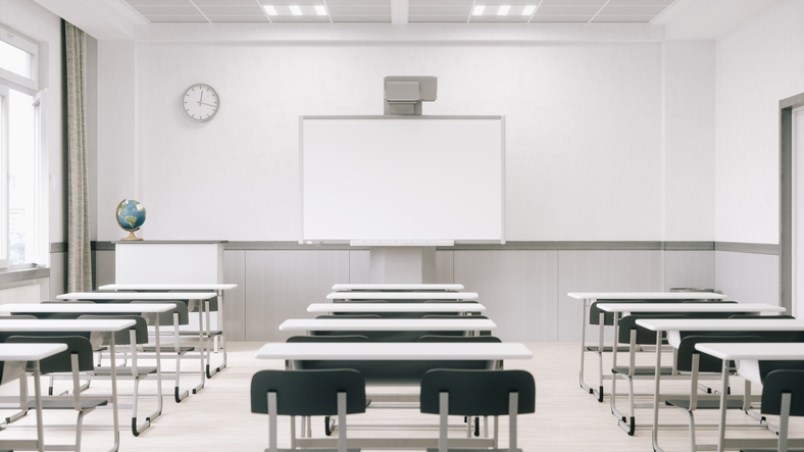School safety advocates are pushing for ventilation upgrades to stop the spread of Omicron, but even if the Burnaby school district got funding for every HVAC project in its newest five-year capital plan, some local schools would still be without adequate ventilation to bring in fresh air and filter out the latest COVID variant.
Eight local schools (Armstrong, Confederation Park, Douglas Road, Lakeview, Lyndhurst, Nelson, Sperling and Twelfth Avenue) don’t have mechanical ventilation in any of their classrooms, while eight more (Cascade Heights, Clinton, Kitchener, Inman, Glenwood, Gilpin, Gilmore and Second Street only have it in some, according to a district-wide audit in September 2021.
The district’s 2022/23 capital plan submission to the provincial government includes a request for more than $5.6 million to get mechanical ventilation into classrooms at Second Street, Gilpin, Lyndhurst, Gilmore, Edmonds, Douglas Road and Burnaby Mountain Secondary, whose HVAC system is coming to the end of its life, according to the district.
The district also hopes to improve ventilation through the province’s annual facility grant, designed to fund projects needed to maintain district facilities.
The district’s application for that grant includes a request for a total of $409,600 for roof-top HVAC units for the gyms at Second Street and Sperling.
School district secretary-treasurer Russell Horswill said the latest capital-plan includes more HVAC projects than usual, and he doesn’t believe Burnaby is alone.
“I would say boards have responded to the health concerns and information received from the BCCDC and the provincial health office, as well, about looking at the need for ventilation,” Horswill said in an interview with the NOW earlier this year when the Delta variant was the province’s main concern. “Our general capital plan is still focused on seismic safety and new schools and replacement of worn-out schools, so that really hasn’t changed as a result of this, but where we can get minor capital funding where we can target it on a certain component of a building, yeah, I would say Burnaby has shifted that for the current capital plan submission around ventilation.”
But even with that shift in focus, the district’s plan for the next five years doesn’t address the needs at 11 schools that have classrooms without mechanical ventilation.
“We will continue to have classrooms that are not connected to mechanical ventilation systems,” Horswill said, “so, in those cases, we will continue to turn the heat up and open windows and doors to create cross-ventilation and continue with all of our other safety processes as well.”
For a handful of classrooms that have neither mechanical ventilation nor windows nor doors that open to the outside, the district has purchased standalone air scrubbers to clean the air.
Horswill said the district will also “continue to work with the ministry (of education) to see if there’s possibilities of how we can get some funding so that we can start to address these school ventilation systems even outside of our capital-plan submission.”
Meanwhile, for schools that do have mechanical ventilation, the district is now using higher grade MERV-13 filters and changing them four times a year instead of twice a year, which was the standard before the pandemic.
The district got about $550,000 from the province for filters and other pandemic-related operational costs and has targeted about $120,000 of that for filter replacements, according to Horswill.
Burnaby teacher Jennifer Heighton, a co-founder of the Safe Schools Coalition, is quoted in the Burnaby Beacon this week saying the education ministry needs to act quickly on a number of fronts besides delaying the start of school after the winter break to stop the spread of Omicron.
Heighton said the most important of those fronts is ventilation upgrades since the variant spreads more easily through the air.
Superintendent Gina Niccoli-Moen sent out a letter to parents Friday, saying the winter break was being extended until Jan. 10 but school administrators and staff would be back at work today (Tuesday).
“Their primary goal will be to review updated health and safety protocols and plan for school start-up,” the letter said.
While there will be no instruction this week, schools will be open for some students, including students with special needs and children of essential healthcare workers, according to the letter.
The province has also asked schools to accommodate the kids of other essential workers, such as teachers, as capacity and staffing levels allow, so the district directed those parents to contact school principals.
“Throughout the many challenges we have endured as a society, school has continued to play a critical role for children and families,” Niccoli-Moen said in the letter. “And while COVID-19 has been anything but predictable, we know that the lessons we have learned and measures we have put in place have held us in good stead. We remain committed to continuing to work through these latest difficulties together.”
Follow Cornelia Naylor on Twitter @CorNaylor
Email cnaylor@burnabynow.com




